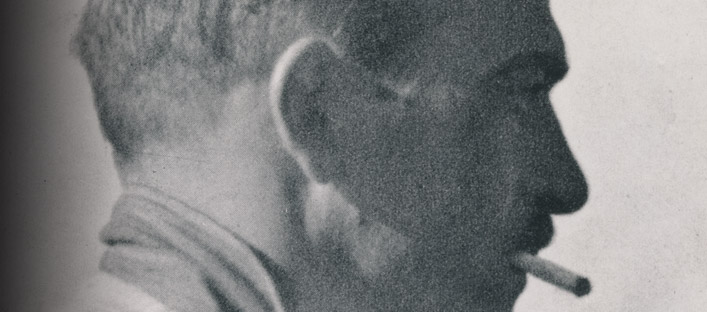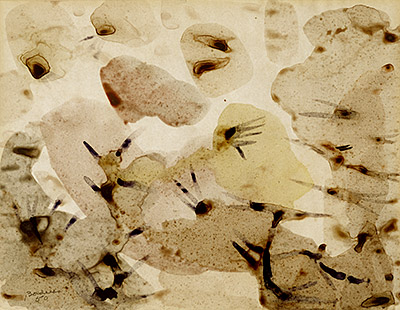In the House of Paul-Émile Borduas

Exploring Borduas' Art
An Art for All the Senses

Paul-Émile Borduas, White Fall, 1950,
watercolor on paper.
Private collection.
Photo MBAM, Christine Guest et Brian Merrett.
© Paul-Émile Borduas Estate / SODRAC (2013)
The artists in the Automatist group were interested in different artistic disciplines, including dance, sculpture, literature and photography. The five senses were thus almost all appealed to at one time or another. However, the most important sense for someone who paints or who looks at a painting is that of sight. One assesses a painting by gazing at it. For Borduas, it was sight that predominated in the perception of a painting, not hearing, taste, smell or touch. Sight is the sense that enables one to appreciate a work of art.
In a 1943 article entitled “Manières de goûter à une oeuvre d’art” (Ways of savouring a work of art), Borduas associates the sense of taste with that of sight, proposing that it is the eye that savours a work and appreciates the artist’s production. Borduas felt that artistic taste had changed over the centuries to become a sort of veil or filter “woven of illusory beauties, exterior qualities and the suggestive power of past masterpieces.” This veil affected the way people looked at paintings and judged them. It shaped their vision of painting and what they believed to be beautiful and good. To paint an abstract work of art or to understand it, Borduas thought that it was necessary to “rediscover a lost harmony, the primordial condition for contemplation” and taste. He wanted to free people’s gaze and their taste from this veil and the preconceived ideas that went with it. The notion of taste was thus linked to the sensitivity of one’s gaze and the emotions felt on contact with a work of art. These feelings engage the viewer and make it possible to savour, or appreciate, an abstract painting. Borduas questioned the factors that had shaped taste in general and, more particularly, those that had shaped his own. He believed that it was this taste, or veil – the traditional vision of art – that prevented him from expressing his inner world.
With respect to the sense of hearing, Borduas, did not devote much thought to music, except perhaps around 1942, when he noticed that his musical tastes changed and evolved very much as his concept of painting did. He also showed a certain interest in music in a letter to his daughter Renée, since she was a pianist. In this letter, he attempted to make a parallel between the work of a painter and that of a musician. For Borduas, music was a preconceived and mechanical art, since it allowed a musician to be totally caught up in composing or interpreting a melody without questioning the way things were done. In music, he felt, the scales, notes and instruments are clear-cut and rule-bound, and they are assimilated by the artist: musicians are not required to think about the technical aspect of their art, but simply express what they feel through music. He believed that when it came to painting, this mechanical aspect was linked to the traditional vision of visual art, divided into genres like landscape painting, portraits or still-life: techniques are clearly established, and artists can devote themselves to representing whatever inspired them. Borduas envisioned his own work in an entirely different way. He sought to renew the artist’s means of expression – a new way that was not weighed down by reference to reality. Automatist painting did not rely on such a pre-established technical basis or a mechanism for simplifying the expression of one’s subconscious.
Header image: Portrait of Paul-Émile Borduas (detail). Gilles Lapointe collection (donation of André G. Bourassa).
Passage from a letter written by Borduas to his daughter Renée, written on January 25, 1955: «…hoping that music will be less demanding on my Renée than painting has been for her father. Art seems to have become the most terrible passion of man – of certain men. Music, because of its mechanical aspects, can save one from an all-consuming fire!»
© Musée des beaux-arts de Mont-Saint-Hilaire, 2014.
All rights reserved.

